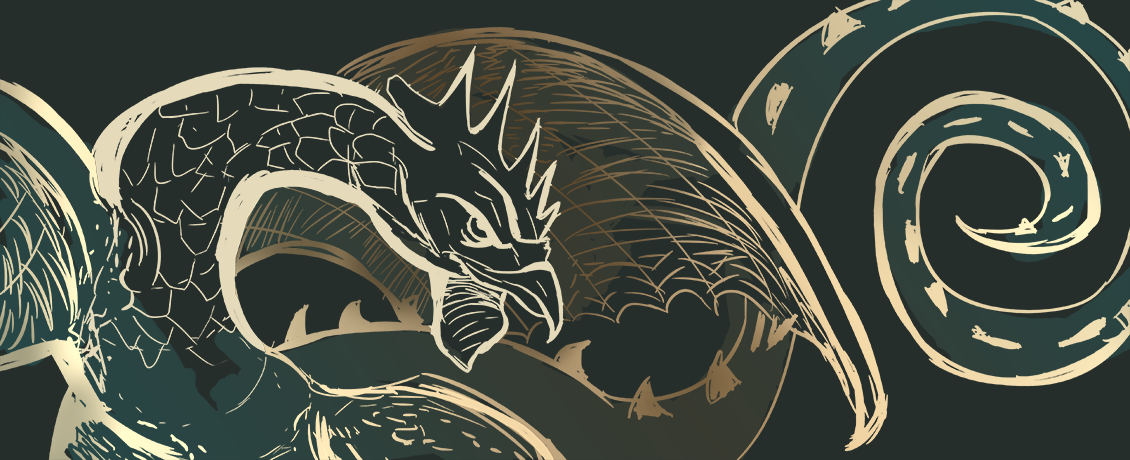Legendary king of serpents. A basilisk has the head of rooster leading into a large body covered in feathers or scales. From its side rises two thorny wings, protruding from its disgusting yellow plumage. It has four or eight legs, and a long serpent's tail. It wears a crown upon its head to symbolize its royal standing.
Basilisk Lore
 Illustration by @danaxbraga
Illustration by @danaxbraga
The Basilisk (which means "little king" when translated from Greek) is declared "king" for a reason. It is one of our most ancient and inevitable representations of evil. Its foulness and power cannot be understated. The Bible, in Psalms 90:13, names it as one of four figures of evil a hero must be prepared to confront: "Thou shalt walk upon the asp and the basilisk: and thou shalt trample underfoot the lion and the dragon". (nb. Other translations of this section of the Bible mention the dragon, another legendary king of serpents) One of the most famous, modern hero myths has the protagonist confront a Basilisk in a "Chamber of Secrets" underneath his school. The awesome power of the Basilisk is demonstrated by the fact that its fang is the only thing that can destroy an artifact of great power which facilitates the will of the antagonist (in fact, it is a lich's phylactery), bringing them one step closer to their ultimate confrontation.
The origins of the Basilisk are contested by scholars. The commonly held belief in the Middle Ages was that a Basilisk was born from the egg of a chicken which was brooded upon by a snake or a toad. In those days, the realms of animals were well defined, and combining two realms that were polar opposites (the realms of birds and serpents) would produce an abomination of extraordinary power. This theory is supported by the most common illustrations of the beast. A basilisk has the head of rooster leading into a large body covered in feathers or scales. From its side rises two thorny wings, protruding from its disgusting yellow plumage. It has four or eight legs, and a long serpent's tail. It wears a crown upon its head to symbolize its royal standing.
But there are older legends. The Roman poet Marcus Annaeus Lucanus describes the origins of the Basilisk in the ninth book of his epic poem Pharsalia. Here is the translation by Robert Graves:
“Medusa is said to have lived in the far west of Africa, at the point where the Ocean laps against the hot earth, in a wide, untilled, treeless region which she had turned entirely to stone merely by gazing around her. The story is that, when her head was cut off, serpents were bred from the fallen blood and came hissing out to display their forked tongues….Perseus had planned to take the quickest route across Europe, but Athene forbade this; asking him to consider the damage he would do if he passed over cities and cultivated lands. On seeing such a large object flying aloft, everyone would look up, and be turned to stone; the corn would also be ruined. So he wheeled about and with the West Wind behind him sailed across Libya, because that was an untilled region, viewed only by the Sun and the stars….Thus, though the Libyan soil was sterile and the fields unproductive, they drank the poisonous blood, dripping from the Medusa’a head, which become more poisonous still by contact with the loose burning earth. The first snake to spring from the ground after this rain of Gorgon’s blood was the deadly asp with its puffed neck; and since the blood happened to be particularly abundant at this point, and mixed with clotted venom, it proved to be the most deadly of all the Libyan varieties….
Among other snakes [is] the Basilisk, which scares away all lesser snakes by its terrifying hiss, and reigns alone over the empty desert–for it can kill without biting.”
Regular readers of Novus Bestiary will be familiar with Medusa and so you will know that the key feature of a gorgon is its terrible gaze. Like the Gorgon, the thing that remains constant throughout every account of the Basilisk is the power of its gaze. It is so powerful, it is hard to describe with words alone. The Basilisk does not merely live in a desert: it makes the desert. Its gaze kills all wildlife in its vicinity. Pliny states that it can even shatter rock and singe the grass. Its poison rots fruits and plants. When it drinks from a river, that river becomes corrupt for hundreds of years. A very stupid adventurer may locate a basilisk easily by searching for the absolute natural destitution surrounding it.
You won't find many basilisks, should you be foolish enough to seek one. Like dragons, most of them disappeared long ago. Some sources claim that a basilisk's blood can transmute stone into other materials, or cure petrification. For this reason, a few adventurers still seek them. If your quest requires it, then there are a few defenses you might employ. Remember first the story of Medusa: the most effective weapon against a Basilisk is its own gaze. Equip yourself with a sturdy mirror, preferably with an inscription of a rooster on the backside. Medieval adventurers used to carry live roosters with them into unknown areas, believing that the rooster's crow would kill a basilisk. I suspect that particular method follows from the medieval accounts of the beast's lineage, and I would not advise you rely on that alone. There is more credence to the medieval idea that basilisk's fear the weasal. Though they cannot kill them, weasals are the natural enemy of the Basilisk and so they are useful for rooting them out.
This poem from Quevedo perfectly illustrates the foolishness of an adventurer who seeks the Basilisk:
If alive he is, who one time saw thee,\ The story he tells of thee is lies,\ For if he died not, he never saw thee,\ And if see thee he truly did, he died.
Written by Giles Ravensong.
